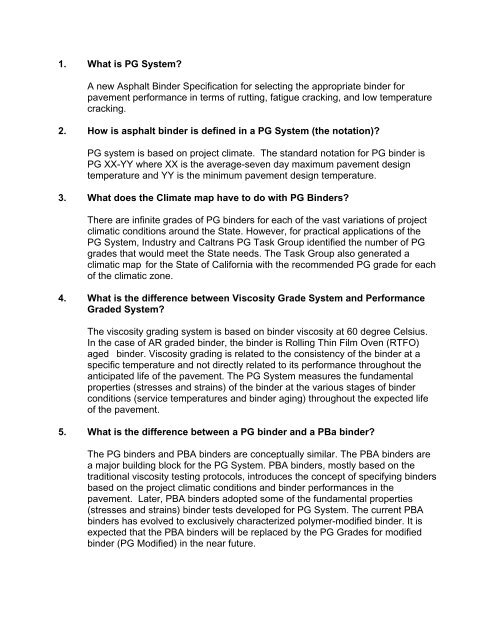1. What is PG System? - Caltrans - State of California
1. What is PG System? - Caltrans - State of California
1. What is PG System? - Caltrans - State of California
You also want an ePaper? Increase the reach of your titles
YUMPU automatically turns print PDFs into web optimized ePapers that Google loves.
<strong>1.</strong> <strong>What</strong> <strong>is</strong> <strong>PG</strong> <strong>System</strong>?<br />
A new Asphalt Binder Specification for selecting the appropriate binder for<br />
pavement performance in terms <strong>of</strong> rutting, fatigue cracking, and low temperature<br />
cracking.<br />
2. How <strong>is</strong> asphalt binder <strong>is</strong> defined in a <strong>PG</strong> <strong>System</strong> (the notation)?<br />
<strong>PG</strong> system <strong>is</strong> based on project climate. The standard notation for <strong>PG</strong> binder <strong>is</strong><br />
<strong>PG</strong> XX-YY where XX <strong>is</strong> the average-seven day maximum pavement design<br />
temperature and YY <strong>is</strong> the minimum pavement design temperature.<br />
3. <strong>What</strong> does the Climate map have to do with <strong>PG</strong> Binders?<br />
There are infinite grades <strong>of</strong> <strong>PG</strong> binders for each <strong>of</strong> the vast variations <strong>of</strong> project<br />
climatic conditions around the <strong>State</strong>. However, for practical applications <strong>of</strong> the<br />
<strong>PG</strong> <strong>System</strong>, Industry and <strong>Caltrans</strong> <strong>PG</strong> Task Group identified the number <strong>of</strong> <strong>PG</strong><br />
grades that would meet the <strong>State</strong> needs. The Task Group also generated a<br />
climatic map for the <strong>State</strong> <strong>of</strong> <strong>California</strong> with the recommended <strong>PG</strong> grade for each<br />
<strong>of</strong> the climatic zone.<br />
4. <strong>What</strong> <strong>is</strong> the difference between V<strong>is</strong>cosity Grade <strong>System</strong> and Performance<br />
Graded <strong>System</strong>?<br />
The v<strong>is</strong>cosity grading system <strong>is</strong> based on binder v<strong>is</strong>cosity at 60 degree Celsius.<br />
In the case <strong>of</strong> AR graded binder, the binder <strong>is</strong> Rolling Thin Film Oven (RTFO)<br />
aged binder. V<strong>is</strong>cosity grading <strong>is</strong> related to the cons<strong>is</strong>tency <strong>of</strong> the binder at a<br />
specific temperature and not directly related to its performance throughout the<br />
anticipated life <strong>of</strong> the pavement. The <strong>PG</strong> <strong>System</strong> measures the fundamental<br />
properties (stresses and strains) <strong>of</strong> the binder at the various stages <strong>of</strong> binder<br />
conditions (service temperatures and binder aging) throughout the expected life<br />
<strong>of</strong> the pavement.<br />
5. <strong>What</strong> <strong>is</strong> the difference between a <strong>PG</strong> binder and a PBa binder?<br />
The <strong>PG</strong> binders and PBA binders are conceptually similar. The PBA binders are<br />
a major building block for the <strong>PG</strong> <strong>System</strong>. PBA binders, mostly based on the<br />
traditional v<strong>is</strong>cosity testing protocols, introduces the concept <strong>of</strong> specifying binders<br />
based on the project climatic conditions and binder performances in the<br />
pavement. Later, PBA binders adopted some <strong>of</strong> the fundamental properties<br />
(stresses and strains) binder tests developed for <strong>PG</strong> <strong>System</strong>. The current PBA<br />
binders has evolved to exclusively characterized polymer-modified binder. It <strong>is</strong><br />
expected that the PBA binders will be replaced by the <strong>PG</strong> Grades for modified<br />
binder (<strong>PG</strong> Modified) in the near future.
6. How to select an asphalt binder grade?<br />
Please go to http://www.dot.ca.gov/hq/oppd/pavement/pgb.htm and click on the<br />
link <strong>Caltrans</strong> Climate Regions for <strong>PG</strong> and <strong>PG</strong> Policy Handout.<br />
7. Why <strong>Caltrans</strong> uses <strong>PG</strong> Binders?<br />
<strong>Caltrans</strong> believed that the <strong>PG</strong> <strong>System</strong> better characterized the fundamental<br />
engineering properties <strong>of</strong> binder. Th<strong>is</strong> will leads to better specification <strong>of</strong> "the best<br />
suited" binder for a particular projects leading to better performing and longer<br />
lasting pavement.<br />
8. <strong>What</strong> are the policies on using <strong>PG</strong> Binders in <strong>California</strong>?<br />
<strong>California</strong> began specifying <strong>PG</strong> grades for unmodified binder since January 1,<br />
2006.<br />
9. <strong>What</strong> are the common <strong>PG</strong> binders used in <strong>California</strong>?<br />
<strong>California</strong> specifies <strong>PG</strong> grades for unmodified binder. The common grades used<br />
in <strong>California</strong> are <strong>PG</strong> 58-22, <strong>PG</strong> 64-10, <strong>PG</strong> 64-16, <strong>PG</strong> 64-28, and <strong>PG</strong> 70-10.<br />
<strong>California</strong> expects to specify <strong>PG</strong> grades for modified binder (<strong>PG</strong> Modified) in the<br />
near future. The expected grades for <strong>PG</strong> Modified are <strong>PG</strong> 58-34M, <strong>PG</strong> 64-28M,<br />
and <strong>PG</strong> 76-22M.<br />
10. Do other <strong>State</strong>s use <strong>PG</strong> Binders?<br />
Currently, all states use <strong>PG</strong> Binders.

















